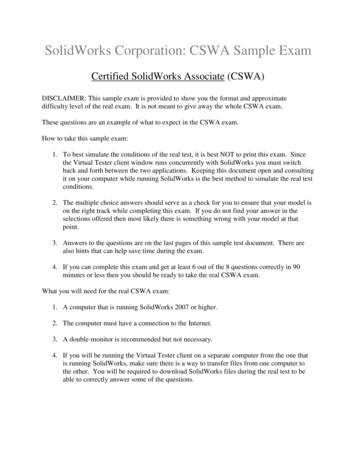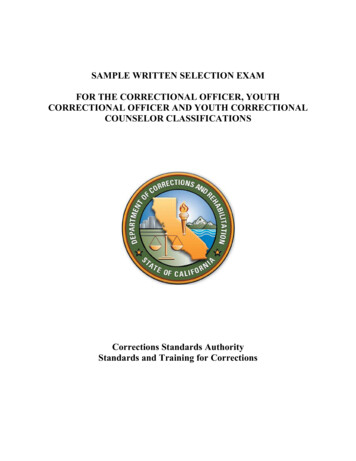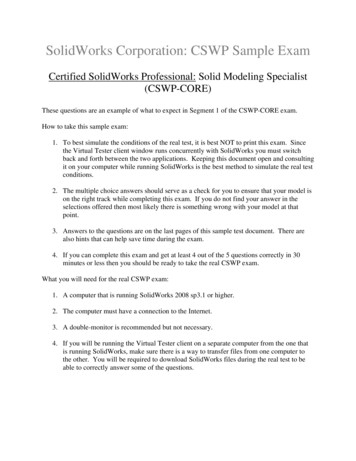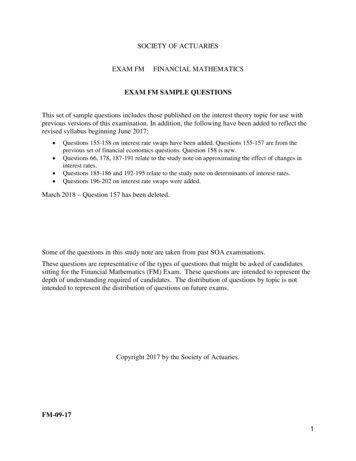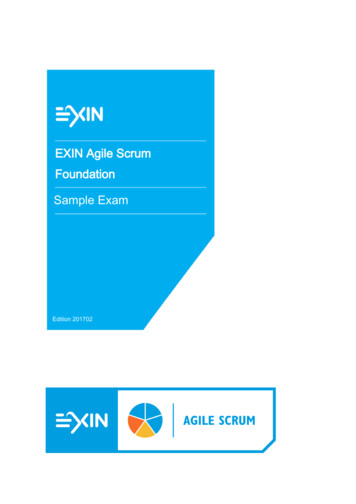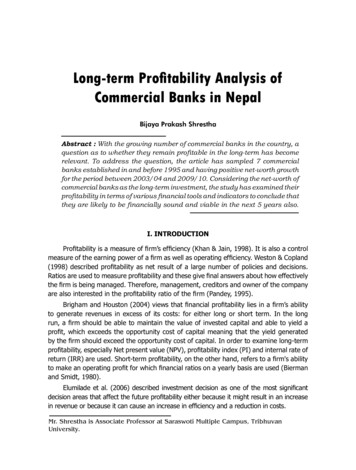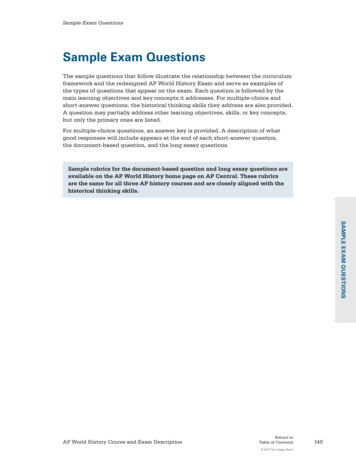
Transcription
Sample Exam QuestionsSample Exam QuestionsThe sample questions that follow illustrate the relationship between the curriculumframework and the redesigned AP World History Exam and serve as examples ofthe types of questions that appear on the exam. Each question is followed by themain learning objectives and key concepts it addresses. For multiple-choice andshort-answer questions, the historical thinking skills they address are also provided.A question may partially address other learning objectives, skills, or key concepts,but only the primary ones are listed.For multiple-choice questions, an answer key is provided. A description of whatgood responses will include appears at the end of each short-answer question,the document-based question, and the long essay questions.Sample rubrics for the document-based question and long essay questions areavailable on the AP World History home page on AP Central. These rubricsare the same for all three AP history courses and are closely aligned with thehistorical thinking skills.Sample Exam QuestionsAP World History Course and Exam DescriptionReturn toTable of Contents 2016 The College Board140
Multiple-Choice QuestionsSection IPart A: multiple-Choice QuestionsAs demonstrated in the following examples, question sets will be organized around twoto five questions that focus on a primary source, secondary source, or historical issue.Set 1: The stela depicting King Hammurabi with an inscription of The Code ofHammurabi provides evidence of state governance in Babylon during the secondmillennium B.C.E. The accompanying questions require that students have anunderstanding of the basis and means by which political elites ruled in earlycivilizations. Students must analyze this source within this specific historicalcontext.Questions 1–3 refer to the image below.Sample Exam QuestionsKharbine-Tapabor / The Art Archive at Art Resource, NYBasalt stela showing King Hammurabi of Babylon (circa 1750 b.c.e.) on the left and the sun godShamash on the right. The Code of Hammurabi is inscribed at the bottom of the stela.AP World History Course and Exam DescriptionReturn toTable of Contents 2016 The College Board141
Multiple-Choice Questions1. The relationship between Hammurabi and Shamash as depicted in the image best illustrateswhich of the following features of ancient civilizations?(A) Rulers deferred to the priestly class for religious guidance.(B) Rulers asserted that royal laws were superior to divine laws.(C) Rulers created new religions to unify conquered peoples.(D) Rulers claimed that their authority derived directly from divine power.Learning ObjectiveSB-1 Explain and compare how rulers constructedand maintained different forms of governance.HistoricalThinking SkillKey Conceptin the CurriculumFrameworkContextualization1.3.II.A2. In addition to commissioning the creation of objects such as the one shown in the image, rulersof early civilizations most commonly used which of the following activities to demonstratetheir religious authority?(A) The creation of systems of record keeping(B) The creation of epic mythologiesSample Exam Questions(C) The construction of water-control systems(D) The construction of monumental architectureLearning ObjectiveCUL-8 Explain how economic, religious, and politicalelites defined and sponsored art and architecture.HistoricalThinking SkillKey Conceptin the CurriculumFrameworkContextualization1.3.III.A3. Which of the following best describes the significance of legal codes to early civilizations?(A) They granted citizens the right to choose their rulers and representatives.(B) They reflected and reinforced existing social and political hierarchies.(C) They facilitated the introduction of monotheistic religions.(D) They effectively settled disputes between pastoralist and agrarian communities.Learning ObjectiveSOC-4 Analyze ways in which legal systems have sustainedor challenged class, gender, and racial ideologies.AP World History Course and Exam DescriptionHistoricalThinking SkillKey Conceptin the n toTable of Contents 2016 The College Board142
Multiple-Choice QuestionsSet 2: This set of questions is based upon a chart representing population changein China from ancient times to 1800 C.E. The accompanying questions requirestudents to account for demographic changes within China during specified timeperiods before 1800. In doing so, students must draw on their understanding ofChinese economic, environmental, and political history as well as their knowledgeof China’s connections and relationships with Eurasia before 1800 C.E. In all of thequestions, students must apply the historical thinking skill of causation.Questions 4–7 refer to the chart below.POPULATION OF CHINA, 400 b.c.e. to 1800 c.e.Sample Exam QuestionsSource: adapted from Quamrul Ashraf and Oded Galor, “Cultural Assimilation, Cultural Diffusion and the Origin of theWealth of Nations,” (2007), accessed at th-take-happen-first4. Which of the following best explains the changes illustrated in the chart during the period400 b.c.e. to 600 c.e.?(A) The development of the Silk Road trade networks(B) The rise and collapse of the Han dynasty(C) The increased number and variety of domesticated animals(D) The development of large cities as social and administrative centersLearning ObjectiveSB-4 Explain and compare how social, cultural,and environmental factors influenced stateformation, expansion, and dissolution.AP World History Course and Exam DescriptionHistoricalThinking SkillKey Conceptsin the CurriculumFrameworkCausation2.2.I2.2.IVReturn toTable of Contents 2016 The College Board143
Multiple-Choice Questions5. Which of the following best explains the changes illustrated in the chart during the period800 c.e. to 1200 c.e.?(A) Lower mortality rates in new trading cities(B) Daoist support for commerce(C) Large-scale migrations of Asian peoples(D) Technological innovations in agricultural productionLearning ObjectiveENV-8 Assess the demographic causes and effects of thespread of new foods and agricultural techniques.HistoricalThinking SkillKey Conceptin the CurriculumFrameworkCausation3.3.I.A6. Which of the following best explains the changes illustrated in the chart during the period1200 c.e. to 1400 c.e.?(A) The Mongol invasions and spread of the bubonic plague(B) An increase in peasant revolts against taxation(C) An increase in the use of coerced laborSample Exam Questions(D) The military expansion of the Islamic caliphateLearning ObjectivesENV-7 Assess the causes and effects of the spread ofepidemic diseases over time.HistoricalThinking SkillKey Conceptsin the CurriculumFrameworkCausation3.1.I.E3.1.IVSB-6 Assess the relationships between stateswith centralized governments and those without,including pastoral and agricultural societies.7. Which of the following best explains the change illustrated in the chart after 1650?(A) The influx of European merchants and trading companies into Asia(B) The widespread adoption of American food crops in Asia(C) The increase in Chinese agricultural exports to Europe and Japan(D) The environmental effects of the Little Ice AgeLearning ObjectiveENV-8 Assess the demographic causes and effects of thespread of new foods and agricultural techniques.AP World History Course and Exam DescriptionHistoricalThinking SkillKey Conceptsin the CurriculumFrameworkCausation4.1.V.B4.1.V.DReturn toTable of Contents 2016 The College Board144
Multiple-Choice QuestionsSet 3: This set of questions is centered on documents that represent interactionsbetween communities within the Persian and Roman empires in the easternMediterranean in the period 600 B.C.E. to 600 C.E. Based on their knowledgeof governance and political authority within these states, students must makeinferences about the relationships between these empires and religious minoritieswithin their borders. In doing so, students must utilize the skills of argumentationand contextualization as well as causation.Questions 8–10 refer to the two sources below.Source 1:“Petition to the Persian governor, from your servants, the Jews of the city of Elephantine [insouthern Egypt]: May the God of Heaven seek your welfare and give you favor before the PersianEmperor Darius II. Three years ago, the local priests of Khnub, a local Egyptian river god,conspired with the local Persian commander to wipe out the temple of our God. The troops and theEgyptians entered the temple and razed it to the ground. Now we, your servants, all say thus: ‘If itplease our lord, please rebuild this temple. If you send a letter to that effect to the city authorities,then the offerings and incense in the new temple shall be offered in your name and all the Jews willpray for you at all times. And you shall have a merit before the God of Heaven even more than aman who offers Him burnt offerings and sacrifices worth a thousand weights of silver and gold.’ ”Sample Exam QuestionsResponse from the governor: “Let this be an instruction to you in Elephantine . . . to rebuild thetemple on its site as it was before, and offerings to be made and incense to be poured on that altar asthey used to be.”Petition of Jewish citizens of Elephantine and response by the Persian governor, 407 b.c.e.Source 2:“When news of the recent fighting between Greeks and Jews in Alexandria reached me, I was notwilling to assign any specific blame, but I have stored up great anger against anyone who beginsfighting again. And I will say that if you do not end this deadly conflict, I will be forced to show youwhat even a benevolent leader is like when he is turned to righteous anger. Therefore, I commandyou, the Alexandrian Greeks, to behave tolerantly and benevolently towards the Jews, since theyhave lived in the same city as you for many years, and not to abuse the religious rites which theypractice, but to allow them to observe their own customs which they observed also in the time ofthe Emperor Augustus. However, I also order the Jews not to agitate for greater privileges than theyenjoyed in the past, and not to send to me in the future another separate delegation to advocatetheir cause, without first referring the matter to the Roman municipal authorities in Alexandria.”Roman Emperor Claudius, letter to the people of Alexandria in Roman Egypt, 41 c.e.AP World History Course and Exam DescriptionReturn toTable of Contents 2016 The College Board145
Multiple-Choice Questions8. The presence of Jewish communities in Elephantine and Alexandria was most directly theresult of which of the following?(A) The proselytizing activities of Jewish priests and missionaries(B) The migration of Jews as a result of foreign conquest and trade opportunities(C) The unification of Israel and Judea under the House of David(D) The expansion of Hellenism in the eastern Mediterranean under the successor states to theMacedonian empireLearning ObjectiveCUL-2 Explain how religious belief systems spread as aresult of expanding communication and exchange networks.HistoricalThinking SkillKey Conceptin the CurriculumFrameworkCausation2.1.I.A9. Taken together, the two sources best illustrate which of the following aspects of politicalauthority in the period circa 600 b.c.e.–600 c.e.?(A) Rulers claimed to rule by virtue of having the approval and support of the gods.(B) Rulers used local administrative institutions to manage the affairs of far-flung regions.Sample Exam Questions(C) Rulers relied on the consent of the governed to prevent religious conflicts.(D) Rulers’ ability to set policies and resolve conflicts was limited by existing legal codes andprecedents.Learning ObjectiveSB-1 Explain and compare how rulers constructedand maintained different forms of governance.HistoricalThinking SkillKey Conceptin the CurriculumFrameworkContextualization2.2.II.A10. Taken together, the two sources best support which of the following inferences about largeempires and religious minorities in the period circa 600 b.c.e.–600 c.e.?(A) Many empires used their militaries to persecute religious groups suspected of beingdisloyal to the state.(B) Led by a desire to preserve political unity, many empires curbed intercommunal conflictsand offered minorities limited religious toleration.(C) Seeking to expand trade, many imperial governments actively encouraged the immigrationof religious minorities and their settlement in imperial cities(D) Because of their traditions of democratic government, empires relied on petitions anddelegations from local populations to help them formulate policies.AP World History Course and Exam DescriptionReturn toTable of Contents 2016 The College Board146
Multiple-Choice QuestionsLearning ObjectivesSB-2 Analyze how the functions and institutionsof governments have changed over time.HistoricalThinking SkillKey Conceptsin the 10 Analyze the political and economic interactionsbetween states and non-state actors.Questions 11–14 refer to the map below.Set 4: This set of questions is based on the analysis of a plan of the capital cityof the Tang Empire in the eighth century C.E. The accompanying questionsrequire student understanding of urban and religious development in Chinawithin a larger Eurasian context during the period 600 C.E. to 1450 and theestablishment and changing nature of relevant trade routes over time. Inaddition to contextualization, students must also employ the historical thinkingskill of causation.PLAN OF THE TANG DYNASTY CAPITAL CITY OF CHANG’AN,NORTH-CENTRAL CHINA, EIGHTH CENTURY c.e.Sample Exam QuestionsSource: adapted from Victor Cunrui Xiong, Sui-Tang Chang’an: A Study In The Urban History of Medieval China, 2000AP World History Course and Exam DescriptionReturn toTable of Contents 2016 The College Board147
Multiple-Choice Questions11. Based on the map and your knowledge of world history, which of the following likelyencouraged the development of cities such as Chang’an?(A) The growth, in volume and extent, of overland trade and commerce(B) Improvements in maritime technology, such as the compass and lateen sail(C) The spread of Buddhism into East Asia(D) Long-distance migrations of central Asian peoplesLearning ObjectiveECON-2 Analyze the economic role of cities as centers ofproduction and commerce.HistoricalThinking SkillKey Conceptin the CurriculumFrameworkCausation3.1.I.A12. The layout of the city as shown in the map most clearly reflects which of the followingdevelopments of the time period?(A) Societies using technological adaptations to deal with changing environments(B) Populations increasing as a result of new crops such as Champa riceSample Exam Questions(C) Cities and towns implementing new measures to control the spread of epidemic disease(D) Governments building infrastructure to promote economic activityLearning ObjectiveSB-5 Assess the degree to which the functions of citieswithin states or empires have changed over time.HistoricalThinking SkillKey Conceptin the CurriculumFrameworkContextualization3.1.I.D13. The variety of temples shown on the map of Chang’an was most likely the result of which of thefollowing broader processes from 600 to 1450 c.e.?(A) Diffusion of cultural traditions along the Silk Roads(B) Conquests by nomadic Central Asian groups(C) Religious conflict resulting from the An Lushan rebellion(D) Neoconfucian influence on the Tang governmentLearning ObjectiveCUL-2 Explain how religious belief systemsdeveloped and spread as a result of expandingcommunication and exchange networks.AP World History Course and Exam DescriptionHistoricalThinking SkillKey Conceptin the CurriculumFrameworkCausation3.1.III.DReturn toTable of Contents 2016 The College Board148
Multiple-Choice Questions14. The integration of natural bodies of water and waterways in the plans for the palace most likelyshows the influence of which of the following?(A) Daoism(B) Confucianism(C) Zoroastrianism(D) BuddhismLearning ObjectiveCUL-1 Compare the origins, principal beliefs, and practicesof the major world religions and belief systems.HistoricalThinking SkillKey Conceptin the CurriculumFrameworkContextualization2.1.II.CSet 5: The questions accompanying this excerpt from the Charter of the DutchWest India Company require that students understand the context, causes, andconsequences of global economic rivalries and strategies between Europeanstates within the period 1450 to 1750.Sample Exam QuestionsQuestions 15–18 refer to the charter below.“We know that the prosperity of the Netherlands and the welfare of their inhabitants dependsprincipally on navigation and trade, and we find by experience that without the common help,assistance, and interposition of a General Company, Dutch merchants cannot be profitablyprotected and maintained in their great risk from pirates, extortion, and otherwise, which willhappen in so very long a voyage. We have found it good that navigation, trade, and commercein the West Indies and Africa should not henceforth be carried on any otherwise than by thecommon united strength of the merchants and inhabitants of the Netherlands. And for that endthere shall be erected one General Company.Moreover, we furnish the General Company with a proper charter and with the followingprivileges and exemptions, namely that for 24 years none of the natives or inhabitants of theNetherlands who are not affiliated with the General Company shall be permitted to sail to theAmericas or the West Indies.”Charter of the Dutch West India Company, 162115. The risks mentioned in the first paragraph are best understood in the context of which of thefollowing historical developments?(A) Competition with African states for the profits from the slave trade(B) Competition with Catholic European states to convert Amerindian peoples(C) Competition with European states for the profits of global trade(D) Competition with Asian empires for the profits of the spice tradeAP World History Course and Exam DescriptionReturn toTable of Contents 2016 The College Board149
Multiple-Choice QuestionsLearning ObjectiveECON-3 Assess the economic strategies ofdifferent types of states and empires.HistoricalThinking SkillKey Conceptin the CurriculumFrameworkContextualization4.3.III16. The privileges and exemptions mentioned in the second paragraph of the passage are best seenas an example of which of the following?(A) Social Darwinism(B) Feudalism(C) Laissez-faire economics(D) Mercantilist practicesLearning ObjectivesECON-3 Assess the economic strategies ofdifferent types of states and empires.HistoricalThinking SkillKey Conceptin the CurriculumFrameworkContextualization4.1.IV.CSample Exam QuestionsECON-13 Analyze how international economic institutions,regional trade agreements, and corporations–both local andmultinational–have interacted with state economic authority.17. Organizations of the type created by the charter most directly contributed to which of thefollowing developments in the period 1450–1750 c.e.?(A) An increase in peasant revolts(B) The emergence of new economic and political elites(C) The implementation of restrictions on religious freedom(D) The spread of Chinese and Indian technologiesLearning ObjectiveSB-4 Explain and compare how social, cultural,and environmental factors influenced stateformation, expansion, and dissolution.AP World History Course and Exam DescriptionHistoricalThinking SkillKey Conceptin the CurriculumFrameworkCausation4.2.II.AReturn toTable of Contents 2016 The College Board150
Multiple-Choice Questions18. The economic activities referenced in the charter most directly contributed to which of thefollowing in the period 1450–1750 C.E.?(A) A decrease in the publication of travel narratives(B) Increased funding for the visual and performing arts(C) Decreased spending on the construction of religious centers(D) Dutch becoming the predominant language for commercial transactionsLearning ObjectiveCUL-9 Explain the relationship between expanding exchangenetworks and the emergence of various forms of transregionalculture, including music, literature, and visual art.HistoricalThinking SkillKey Conceptin the CurriculumFrameworkCausation4.1.VIISample Exam QuestionsSet 6: This set of questions — centered on the speech by the British governorof Bombay Presidency in 1863 — explores the causes and consequences ofintensifying industrialization and changes in communication and transportationtechnologies on European colonies such as India. Students must analyze the ideasexpressed in the governor’s speech within their historical context.Questions 19–23 refer to the passage below.“I can safely say that before the commencement of what I may call the Railway Period, not onlywere the wages in most parts of the country established by tradition and authority, rather thanby the natural laws of supply and demand, but the opportunity to work was in general restrictedto particular spots. For the first time in history the Indian finds that he has in his power of labora valuable possession which, if he uses it right, will give him something much better than meresubsistence. Follow him to his own home, in some remote village, and you will find that the railwaylaborer has carried to his own village not only new modes of working, new wants, and a newfeeling of self-respect and independence, but new ideas of what government and laws can offerhim. And he is, I believe, a better and more loyal subject, as he is certainly a more useful laborer.”Bartle Frere, British governor of the Bombay Presidency, India,speech on opening of a rail line, 186319. Frere’s speech is best understood in the context of which of the following?(A) Governments in Asian empires undertaking economic reforms to catch up with Europeanpowers(B) Governments undertaking political and social reforms to mitigate the effects of industrialcapitalism(C) Governments expanding and consolidating their empires using their increasing industrial power(D) Governments promoting redistributionist policies to reduce income inequality betweenlabor and capitalAP World History Course and Exam DescriptionReturn toTable of Contents 2016 The College Board151
Multiple-Choice QuestionsLearning ObjectiveSB-3 Analyze how state formation and expansion wereinfluenced by various forms of economic organization, suchas agrarian, pastoral, mercantile, and industrial production.HistoricalThinking SkillKey Conceptin the CurriculumFrameworkContextualization5.2.I.A20. The developments described in the speech regarding the lifting of traditional restrictions onIndian labor contributed most directly to which of the following global processes?(A) Protests for improved sanitation and living conditions in industrial cities(B) Long-distance and overseas migrations of contractual and coerced workers(C) The decline of Spanish and Portuguese influence in the Indian Ocean(D) The emergence of new racial ideologies that supported European imperialismLearning ObjectiveECON-6 Explain and compare the causes and effectsof different forms of coerced labor systems.HistoricalThinking SkillKey Conceptin the CurriculumFrameworkCausation5.4.II.BSample Exam Questions21. Which of the following best explains Frere’s characterization of the time of his speech as the“Railway Period” in British India?(A) Railways provided a means for Hindu pilgrims to visit sacred sites quickly and cheaply.(B) Railways allowed British missionaries to spread Christianity more effectively.(C) Railways opened up access to interior markets and resources for British commercial interests.(D) Railways eased the overcrowding in Indian cities by allowing industrial workers tocommute from suburban areas.Learning ObjectiveECON-12 Evaluate how and to what extent networks ofexchange have expanded, contracted, or changed over time.AP World History Course and Exam DescriptionHistoricalThinking SkillKey Conceptin the CurriculumFrameworkContextualization5.1.IVReturn toTable of Contents 2016 The College Board152
Multiple-Choice Questions22. Frere’s view of the changing opportunities for Indian labor most directly reflects the influenceof which of the following?(A) The ideals of classical liberalism as stated by Adam Smith and John Stuart Mill(B) The ideals of communism as stated by Karl Marx and Friedrich Engels(C) The ideals of the Enlightenment as stated by political revolutionaries such as Simon Bolívar(D) The ideals of mercantilism as developed by state-sponsored joint-stock trading companiessuch as the British East India CompanyLearning ObjectivesCUL-3 Explain how major philosophies and ideologiesdeveloped and spread as a result of expandingcommunication and exchange networks.HistoricalThinking SkillKey Conceptin the CurriculumFrameworkContextualization5.1.II.AECON-3 Assess the economic strategies ofdifferent types of states and empires.ECON-9 Explain and compare the ways in which economicphilosophies influenced economic policies and behaviors.Sample Exam Questions23. Which of the following later developments would most undermine the hopes set forth by Frerein the last sentence of his speech?(A) Easier access to Indian raw materials led to a decrease in prices of British manufacturedgoods.(B) Japanese emulation of Western models of development spurred imperial rivalries that ledto the Second World War.(C) Improved transportation and communication in India helped develop a shared sense ofidentity that led to greater Indian nationalism.(D) Increased migration would lead to the creation of Indian ethnic enclaves in Great Britainand other parts of the British Empire.Learning ObjectivesCUL-3 Explain how major philosophies and ideologiesdeveloped and spread as a result of expandingcommunication and exchange networks.HistoricalThinking SkillKey Conceptin the CurriculumFrameworkCausation6.2.II.ASB-9 Assess how and why commercialexchanges have influenced the processes ofstate building, expansion, and dissolution.SOC-7 Analyze the ways in which colonialism, nationalism,and independence movements have sustained orchallenged class, gender, and racial ideologies.AP World History Course and Exam DescriptionReturn toTable of Contents 2016 The College Board153
Multiple-Choice QuestionsSet 7: In these passages from a school history book from Mexico in 1951, studentsneed to recognize that historical interpretations, both in the past and the present,reflect the historical and contemporary contexts in which the historical accountswere created. Students need to employ their understanding of the historicalcontexts of the mid-20th century and the early 21st century to analyze thesequestions that engage with the historical thinking skill of interpretation.Questions 24–26 refer to the passage below.Political Consequences of the Spanish Conquest of MexicoBecause Mexico was the most important of the Spanish conquests, it was governed by rulers ofvery high standing, almost equal to that of the Spanish kings. In this way the inhabitants of ourRepublic—Indians of different races, mestizos [people of Spanish and Indian parentage], andcriollos [American-born people of European ancestry]—all became accustomed to feeling Mexicanand to loving one another as compatriots. This was surely the most important consequence of theconquest, because it was for this reason that dispersed and different tribes of Indians came to bepatriotic Mexicans, without distinction of race and color.Ethnic Consequences of the ConquestSample Exam QuestionsThe Spaniard as an individual is sometimes a proud man, and prone to violent short-temperedness;however, the populating of the lands that he conquered and colonized is a living testimony tothe fact that his soul contains a profound feeling for all humanity. He never accepted the hatefulidea that there are inferior races that are destined to perish en masse or serve forever others whoconsider themselves superior. The consequence of this worldview was that, beginning with Cortéshimself and his captains, the conquistadors and colonizers fully mixed with the Indians, whichbrought into being the mestizo, which currently constitutes the most important element of theMexican population. A moment will soon come when the people of Mexico are unified by the lovefor their country.”Elementary school history book approved for use in all Mexican schools byMexico’s Ministry of Education, 195124. The interpretation of Mexican history presented in the passage is most strongly influenced bywhich of the following?(A) Marxism(B) Anticolonialism(C) Social Darwinism(D) NationalismAP World History Course and Exam DescriptionReturn toTable of Contents 2016 The College Board154
Multiple-Choice QuestionsLearning ObjectivesSB-4 Explain and compare how social, cultural,and environmental factors influenced stateformation, expansion, and dissolution.HistoricalThinking SkillKey Conceptin the CurriculumFrameworkInterpretation5.3.IISOC-7 Analyze the ways in which colonialism, nationalism,and independence movements have sustained orchallenged class, gender, and racial ideologies.25. The reference in the second paragraph to “the hateful idea that there are inferior races” is bestunderstood in the context of which of the following twentieth-century developments?(A) The Spanish Civil War(B) The final dissolution of the Spanish colonial empire(C) The Holocaust in Europe during the Second World War(D) The migration of former colonial subjects to EuropeSB-7 Assess how and why internal conflicts, such asrevolts and revolutions, have influenced the processof state building, expansion, and dissolution.Key Conceptin the e Exam QuestionsLearning ObjectiveHistoricalThinking Skill26. Present-day historians would most likely agree with which of the following aspects of theinterpretation in the 1951 school textbook?(A) The omission of the demographic effects of the Spanish conquest on the Indians(B) The claim that the ethnic and racial
Chinese economic, environmental, and political history as well as their knowledge of China’s connections and
